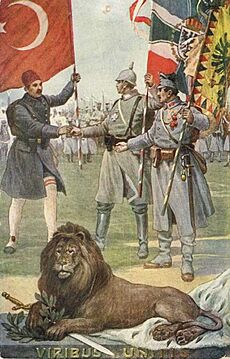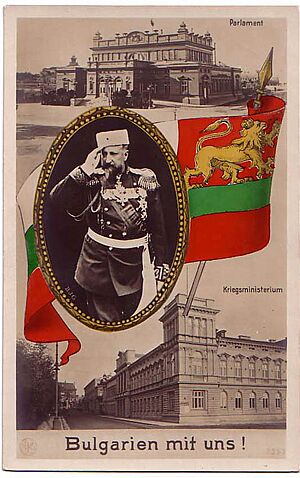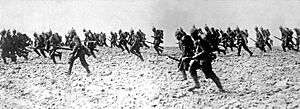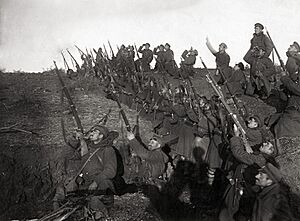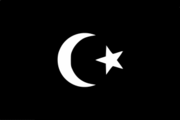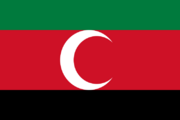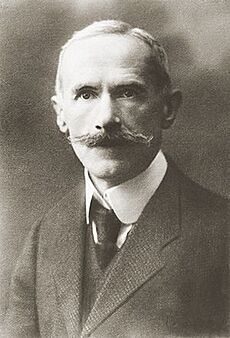Central Powers facts for kids
Quick facts for kids
Central Powers
|
|||||||||||||
|---|---|---|---|---|---|---|---|---|---|---|---|---|---|
| 1914–1918 | |||||||||||||

The Central Powers as of 14 October 1915 in Europe.
|
|||||||||||||

Central Powers around the world in orange.
|
|||||||||||||
| Status | Military alliance | ||||||||||||
| Membership |
|
||||||||||||
| Historical era | World War I | ||||||||||||
|
• Established
|
1914 | ||||||||||||
|
• Dissolved
|
1918 | ||||||||||||
|
|||||||||||||

The Central Powers were a group of countries that formed one of the two main sides during World War I, which lasted from 1914 to 1918. This powerful alliance included the German Empire, Austria-Hungary, the Ottoman Empire, and the Kingdom of Bulgaria. Sometimes, they were also called the Quadruple Alliance because of these four main members.
The alliance began in 1879 with an agreement between Germany and Austria-Hungary. While Italy was initially part of a different alliance with Germany and Austria-Hungary, it chose not to join the Central Powers in World War I. Instead, Italy later fought alongside their opponents, the Allied Powers. The Ottoman Empire and Bulgaria joined the Central Powers after the war had already started.
The Central Powers fought against the Allied Powers, who were mainly formed around the Triple Entente. In the end, the Central Powers were defeated in 1918, leading to the end of their alliance.
Contents
- Understanding the Name 'Central Powers'
- Working Together: Economic Plans
- How the Central Powers Formed
- Key Countries of the Central Powers
- Other Groups Supporting the Central Powers
- Client States of the Central Powers
- Nations Supported by the Central Powers
- Non-State Fighters Supporting the Central Powers
- End of the War: Armistices and Treaties
- Leaders of the Central Powers
- Central Powers Statistics
- The Central Powers Fall Apart
- Images for kids
- See also
Understanding the Name 'Central Powers'
The name 'Central Powers' came from where these countries were located on the map. They were positioned in the middle of Europe, between the Russian Empire to the east and France and the United Kingdom to the west. This central location gave them their name.
Interestingly, in some other languages, like Turkish and Chinese, the Central Powers were called 'Allied States,' which can be a bit confusing since they were fighting against the main Allied Powers.
Working Together: Economic Plans
Germany had ideas for a special economic group called Mitteleuropa (which means 'Central Europe'). This plan aimed to create closer economic ties between Germany, Austria-Hungary, and other countries in the region.
How the Central Powers Formed
Early Alliances and War Declarations
The first major event was on July 28, 1914, when Austria-Hungary, with Germany's support, declared war on Serbia. Germany stood by its ally, Austria-Hungary, hoping to keep the conflict small. However, this did not happen.
The Ottoman Empire was officially neutral at first. But they had a secret agreement with Germany. For about two months, the Ottoman government prepared for war, favoring German interests. On October 29, 1914, the Ottoman Empire officially joined the war with the Central Powers. This happened after their navy, using ships bought from Germany, attacked Russian ports.
Bulgaria Joins the Alliance
In 1915, both sides of the war tried to get Bulgaria to join them. Bulgaria decided to join Germany and its allies. They signed a treaty with Germany, Austria-Hungary, and the Ottoman Empire. This made the Central Powers even stronger.
King Ferdinand of Bulgaria wanted to gain land from Serbia, which was a rival. Joining the Central Powers seemed like the best way to achieve this. As part of the agreement, Bulgaria's army would follow orders from the German Emperor.
Key Countries of the Central Powers
These were the main countries that formed the Central Powers alliance during World War I:
| Nation | Date of Entry |
|---|---|
| July 28, 1914 | |
| August 1, 1914 | |
| October 29, 1914 | |
| October 14, 1915 |
When the war began, the Central Powers included the German Empire and Austria-Hungary. The Ottoman Empire joined a few months later in 1914, and the Tsardom of Bulgaria joined in 1915.
German Empire
Why Germany Entered the War

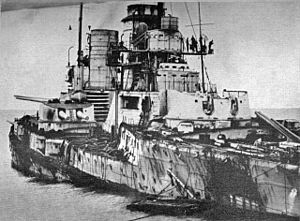
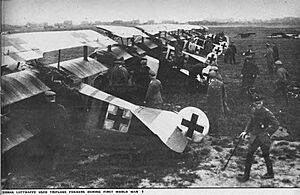
In July 1914, after the assassination of Archduke Franz Ferdinand of Austria, Germany promised to support Austria-Hungary if a war started with Serbia. When Russia began to prepare its army, Germany saw this as a threat.
Germany believed Russia's actions meant war was coming. So, on August 1, Germany sent an ultimatum to Russia. Later that day, France, an ally of Russia, also began to prepare its army.
On August 3, 1914, Germany declared war on France. Germany had a plan, called the Schlieffen Plan, to quickly defeat France by moving its army through Belgium. Belgium was a neutral country and did not want German troops on its land. Germany ignored Belgium's neutrality and invaded. This action caused Great Britain to declare war on Germany, as Britain had promised to protect Belgium's neutrality.
Later, other countries like Italy (in 1916), the United States (in 1917), and Greece (in 1917) also declared war on Germany.
German Colonies and Territories
Germany had several colonies and territories around the world.
European Territories
Germany controlled Alsace–Lorraine, a region it had taken from France in an earlier war. This region was returned to France after World War I.
African Colonies
Germany started building its colonial empire later than other European powers. It gained control of several areas in Africa:
- Cameroon was a German colony from 1884 until 1915. After the war, it was given to France.
- German East Africa included parts of modern-day Tanzania, Rwanda, and Burundi. It was the only German colony not fully conquered during the war. It was later divided among other Allied powers.
- South West Africa (now Namibia) became German in 1885. It was taken over by South Africa in 1915.
- Togoland (now part of Ghana) was a German protectorate. It was quickly occupied by the Allies in 1915 and divided between France and Britain.
Asian and Pacific Territories
Germany also had territories in Asia and the Pacific:
- The Jiaozhou Bay Leased Territory in China was leased by Germany. Japanese forces took control of it during the war.
- German and Austrian areas in Chinese cities like Tianjin and Hankou were also invaded.
- German New Guinea in the Pacific was occupied by Australian forces in 1914.
- German Samoa was occupied by New Zealand forces in 1914.
Austro-Hungarian Empire
Why Austria-Hungary Entered the War

Austria-Hungary believed that Serbia was involved in the assassination of Archduke Franz Ferdinand. They saw this as a dangerous act that could encourage other groups within their diverse empire to rebel.
Austria-Hungary sent a list of demands to Serbia, asking for a full investigation and cooperation. Serbia agreed to most demands, but Austria-Hungary found this insufficient. They used this as a reason to declare war.
Russia warned Austria-Hungary not to invade Serbia. However, with Germany's support, Austria-Hungary hoped Russia would not get involved.
When Austria-Hungary invaded Serbia, Russia declared war on Austria-Hungary. Then, Germany declared war on Russia, starting the chain reaction that led to World War I. On August 6, 1914, Emperor Franz Joseph of Austria-Hungary signed the declaration of war on Russia to support his German ally.
Austro-Hungarian Territories
Austria-Hungary was a large empire made up of two main parts: Austria and Hungary. Each had its own government but shared the same ruler, the Habsburg monarch. It included many different regions and peoples.
Ottoman Empire
Why the Ottoman Empire Entered the War

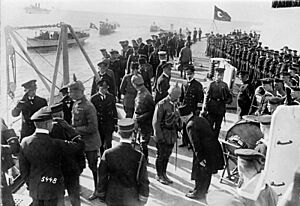
The Ottoman Empire joined the Central Powers in November 1914. They had strong economic ties with Germany, especially through a railway project connecting Berlin to Baghdad. A formal alliance with Germany was signed on August 2, 1914.
For the first few months of the war, the Ottoman Empire remained neutral. However, they allowed a German naval squadron to stay near the Bosphorus strait. Germany also provided financial aid and weapons to the Ottoman Empire.
Germany pressured the Ottoman government to fulfill its alliance duties. The Ottoman Empire then entered the war by launching a naval attack on Russian ports. Soon after, the Allied Powers declared war on the Ottoman Empire.
Bulgaria
Why Bulgaria Entered the War
After losing territory to Serbia, Greece, and Romania in an earlier conflict (the Second Balkan War), Bulgaria signed a defensive alliance with the Ottoman Empire in August 1914. Bulgaria was the last major country to join the Central Powers, doing so in October 1915 by declaring war on Serbia. It invaded Serbia alongside German and Austro-Hungarian forces.
Bulgaria wanted to reclaim the region of Vardar Macedonia, which Serbia controlled. As a condition for joining the Central Powers, Bulgaria was promised this territory.
Other Groups Supporting the Central Powers
Some other groups and states also cooperated with the Central Powers, even if they weren't official members.
South African Republic
In September 1914, some Boer army officers in South Africa, who were against the Union of South Africa joining the war, tried to re-establish the South African Republic. Germany supported these rebels, but they were defeated by South African government forces by February 1915.
Senussi Order
The Senussi Order was a religious and political group in Libya. In 1915, they were encouraged by the Ottoman Empire and Germany to declare a holy war. They attacked Italy in Libya and the United Kingdom in Egypt.
Sultanate of Darfur
In 1915, the Sultanate of Darfur in Sudan broke away from the Sudanese government and allied with the Ottomans. British and Egyptian forces invaded to prevent an attack on Sudan. The sultan was killed in November 1916, ending the conflict.
Zaian Confederation
The Zaian Confederation fought against France in the Zaian War (1914-1921) to stop French expansion into Morocco. The Central Powers, especially Germany, tried to stir up trouble to distract French forces from Europe.
Dervish State
The Dervish State in Somalia fought against the British, Ethiopian, Italian, and French empires. During World War I, they received supplies from Germany and the Ottoman Empire to continue their fight.
Client States of the Central Powers
Both the Ottoman and German Empires had "client states," which were smaller states under their influence or control.
| Client State | Controlling Power |
|---|---|
| Courland and Semigallia | |
| United Baltic Duchy | |
| Yemen |
Nations Supported by the Central Powers
These countries were not official members but cooperated with the Central Powers.
Ethiopia
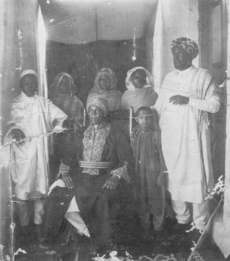
The Ethiopian Empire was officially neutral during World War I. However, its ruler, Lij Iyasu, was thought to be sympathetic to the Ottoman Empire. Germany tried to encourage Ethiopia to support uprisings in East Africa. Ethiopia might have supplied weapons to Muslim rebels, indirectly helping the Central Powers.
In 1916, Ethiopian nobles, fearing Iyasu's growing influence and ties to the Ottoman Empire, removed him from power. A new regent, Ras Tafari Makonnen, who was less pro-Ottoman, took control.
Liechtenstein
Liechtenstein was officially neutral. However, its people and government generally supported the Central Powers, especially Austria-Hungary, with whom they had close economic ties. As the war continued, food supplies from Austria-Hungary decreased, forcing Liechtenstein to seek help from Switzerland. The Allied countries also placed an embargo on Liechtenstein due to its connections with the Central Powers, causing economic hardship.
Kingdom of Greece
The Kingdom of Greece had internal political disagreements. The Central Powers supported the Greek royalists until King Constantine stepped down in 1917.
Romania
After signing a ceasefire with the Central Powers, Romania later rejoined the war against them on November 10, 1918.
Non-State Fighters Supporting the Central Powers
Various groups also supported the Central Powers for their own reasons. For example, some Irish Nationalists launched the Easter Rising in Dublin in April 1916, referring to their "gallant allies in Europe." Also, Józef Piłsudski was allowed by Germany and Austria-Hungary to form Polish legions to fight against Russia.
- Irish Citizen Army
- Irish Republican Brotherhood
- Irish Volunteers
- White Guard (Finland)
- Polish Legions
- IMRO
- Ahl Haydara Mansur
End of the War: Armistices and Treaties
The Central Powers began to surrender in late 1918.
| Country | Date |
|---|---|
| September 29, 1918 | |
| October 30, 1918 | |
| November 4, 1918 | |
| November 11, 1918 |
Bulgaria signed a ceasefire with the Allies on September 29, 1918. The Ottoman Empire followed on October 30, 1918. Austria-Hungary signed ceasefires in early November as its empire began to break apart. Germany signed the armistice ending the war on November 11, 1918.
The war did not end with one single treaty for all Central Powers. Instead, each country signed separate peace treaties.
| Country | Treaty of | Key Results | Date Signed |
|---|---|---|---|
| Versailles | Germany had to reduce its military, give up territory, and pay a large amount of money for war damages. | June 28, 1919 | |
| Saint-Germain | September 10, 1919 | ||
| Neuilly | November 27, 1919 | ||
| Trianon | Hungary lost a large amount of its land and many Hungarian people became minorities in neighboring countries. | June 4, 1920 | |
| Sèvres/Lausanne | The Treaty of Sèvres caused a war in Turkey, leading to a new treaty, the Treaty of Lausanne. | August 10, 1920/August 24, 1923 |
Leaders of the Central Powers
| Portrait | Leader | Title | Time period |
|---|---|---|---|
 |
Franz Joseph I | Emperor of Austria and Apostolic King of Hungary | 1848–1916 |
 |
Karl I | Emperor of Austria and Apostolic King of Hungary | 1916–1918 |
 |
Wilhelm II | German Emperor | 1888–1918 |
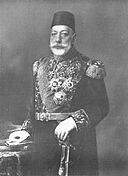 |
Mehmed V | Sultan of the Ottoman Empire | 1909–1918 |
 |
Mehmed VI | Sultan of the Ottoman Empire | 1918–1922 |
 |
Ferdinand I | Tsar of Bulgaria | 1887–1918 |
| Ali Dinar | Sultan of Darfur | 1899–1916 | |
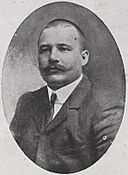 |
Manie Maritz | Leader of the Maritz Rebellion | 1914–1915 |
 |
Mohammed Abdullah Hassan | Emir of the Dervish State | 1896–1920 |
 |
Ahmed Sharif as-Senussi | Leader of the Senussi | 1902–1933 |
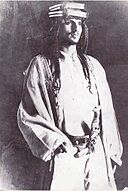 |
Saud bin Abdulaziz | Emir of Jabal Shammar | 1908–1920 |
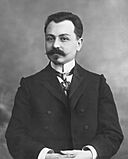 |
Fatali Khan Khoyski | Prime Minister of Azerbaijan | 1918–1919 |
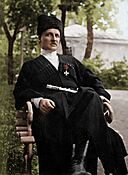 |
Pavlo Skoropadskyi | Hetman of Ukraine | 1918–1918 |
Central Powers Statistics
| Country | Population (millions) |
Area (million km2) |
GDP ($ billion) |
GDP per capita ($) |
|
|---|---|---|---|---|---|
| Mainland | 67.0 | 0.5 | 244.3 | 3,648 | |
| Colonies | 10.7 | 3.0 | 6.4 | 601 | |
| Total | 77.7 | 3.5 | 250.7 | 3,227 | |
| 50.6 | 0.6 | 100.5 | 1,980 | ||
| 23.0 | 1.8 | 25.3 | 1,100 | ||
| 4.8 | 0.1 | 7.4 | 1,527 | ||
| Total | 156.1 | 6.0 | 383.9 | 2,459 | |
| Allies, total, November 1914 | 793.3 | 67.5 | 1,096.5 | ||
| UK, France and Russia only | 259.0 | 22.6 | 622.8 | ||
| Country | Mobilized Soldiers | Killed in Action | Wounded | Missing in Action | Total Casualties | Casualties as % of Total Force |
|---|---|---|---|---|---|---|
| 13,250,000 | 2,037,000 (13.65%) | 6,267,143 | 1,152,800 | 9,456,943 | 71% | |
| 7,800,000 | 1,494,200 (11.82%) | 3,620,000 | 2,200,000 | 7,314,200 | 94% | |
| 3,056,000 | 771,884 (10.84%) | 763,163 | 250,000 | 1,785,000 | 60% | |
| 1,200,000 | 75,844 (6.32%) | 153,390 | 27,029 | 255,263 | 21% | |
| Total | 25,257,321 | 4,378,928 | 10,803,533 | 3,629,829 | 18,812,290 | 75% |
The Central Powers Fall Apart
Growing Disagreements Among Allies
As the war continued longer than expected, Germany's allies started to want more independence. When Francis Joseph died and Charles became emperor, Austria-Hungary began to distance itself from Germany's policies. Emperor Charles moved his army's headquarters to show he wanted more control.
By 1916, leaders in Austria-Hungary desperately wanted to leave the war. They feared their empire would break apart if the fighting continued.
Also, after peace treaties in early 1918, the Bulgarian government changed. The new leaders were less loyal to the alliance with Germany. Bulgarian leaders felt cheated by how conquered lands were divided. This led to unhappiness and criticism of Germany and Austria-Hungary in Bulgaria.
Bulgaria Leaves the War
French and Serbian troops launched a strong attack against Bulgarian forces in Macedonia. The Bulgarian soldiers were tired, lacked supplies, and many were deserting. This attack quickly broke through the front lines.
Facing this serious situation, the German high command ordered troops from Ukraine to move to the Balkans. They tried to set up a new defense line. Germany also tried to keep Bulgaria in the alliance. However, Bulgaria quickly negotiated an armistice (a ceasefire) with the Allies, which took effect on September 29, 1918.
Images for kids
See also
 In Spanish: Potencias Centrales para niños
In Spanish: Potencias Centrales para niños
- Central Powers intervention in the Russian Civil War
- Color books, transcripts of official documents released by each nation early in the war
- Diplomatic history of World War I
- Home front during World War I covering all major countries
- International relations (1814–1919)
- Axis powers
- Kaiserreich (disambiguation)
- Spa Conferences (First World War)


